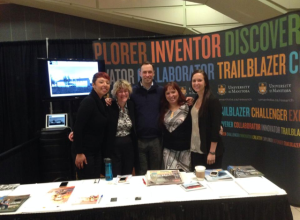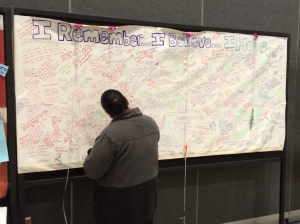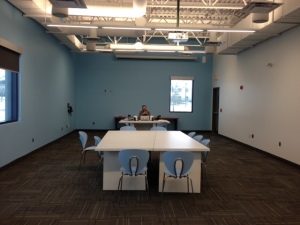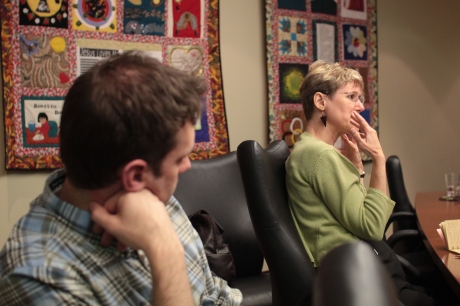Guest post by Nicole Courrier
Wisdom: one of the seven sacred teachings, and the teaching chosen to represent the final Truth and Reconciliation Commission National Event which took place in Edmonton March 27th-30th. Each national event was based on a sacred teaching, the others being respect, courage, love, truth, humility and honesty. But I couldn’t have chosen a better word to describe my overall experience at the TRC event. The wisdom I witnessed and received made the experience one I will never forget.
As a first year Archival Studies masters student I was asked to attend the event to work the National Research Centre for Truth and Reconciliation (NRC) booth by University Archivist Shelley Sweeney, who I had been working for at the University of Manitoba Archives & Special Collections. Joining us were Director of the NRC Ry Moran, Indigenous Services Librarian at the University of Manitoba Camille Callison and University of Manitoba student Kyra Wilson who represented the student voice on the NRC panel.
 From left-right: Kyra Wilson, Shelley Sweeney, Ry Moran, Camille Callison, Nicole Courrier
From left-right: Kyra Wilson, Shelley Sweeney, Ry Moran, Camille Callison, Nicole Courrier
It was an emotional event to say the least. The opening ceremony began with a Lakota Stoney drumming performance, and seeing the traditional outfits brought tears to my eyes as I was reminded that many of the people surrounding me were ripped from their beautiful culture at a young age.

I viewed the event through the lens of a sister, daughter, history student, archivist and “young” Canadian. Returning to the sacred teaching of wisdom, I can say I was touched and enlightened within all of these various lenses. First, I was reminded to fully appreciate my family and the privileged childhood I was so fortunate to have. Family was really the center of the event. Survivors gave statements surrounded by their families, they spoke of the loss of family, apologized to family, and praised family members on their success. Sitting at the NRC booth I heard so many heartwarming stories of proud parents and grandparents of their children and/or grandchildren’s successful and happy lives. People approached the NRC booth so willing to share their genealogy and the long nomadic history of their ancestors, which I was fascinated with as a history student. Recently completing a history seminar in Aboriginal Rights, the experience allowed everything I had learnt to come full circle and to see firsthand the devastating outcomes of a long history of colonialism in Canada. As a student, the privilege of education was reinforced and more importantly I was reminded of other ways in which to learn. As a “young” Canadian, it is essential that we take it upon ourselves to become informed about the past, present and future of Indigenous Peoples in Canada. It is unacceptable to have any Canadian citizen be unaware of this dark chapter of Canadian history.

As an Archival Studies student, I was extremely fortunate to have the chance to attend the final national event. It was so uplifting to hear people asking about where the church archives booths were located so they could look for themselves or their loved ones in the many large binders filled with copies of photographs from various Indian Residential Schools. Sitting at the NRC booth allowed me the chance to discuss with people about the NRC and the amazing mass of TRC records that will be transferred over, as well as the importance of archives as a center of national memory. I heard many people fear that the NRC would become “just an archive.” On the one hand, as an Archival Studies student it’s hard to hear people either unaware of what an archive is, or dismissive of its role in social justice. However, the fear of “just an archive” was reiterated in the NRC panel, where survivors and others hoped the NRC would be a space completely unique from a traditional archive. This I think is essential. That the NRC will reinforce the importance of Indigenous culture and custom, and I hope too that it in this aspect it will be more than “just an archive.” Justice Murray Sinclair stated at the NRC Panel, “it cannot be all things to all people.” With this said, I am confident the NRC will be a place where survivors and their families can heal, and that academics and the general public will use the NRC as a place to educate and inform and be educated and informed.
I heard many stories. Many emotional, some laced with anger or bitterness, and others were told with humor or a happy ending. However, the most memorable story I heard at the event was a survivor that grabs a coffee at his local Tim Hortons and educates customers about Indian Residential Schools and the Truth and Reconciliation Commission. He shares his wisdom one timbit at a time. It doesn’t get much more Canadian than that.



